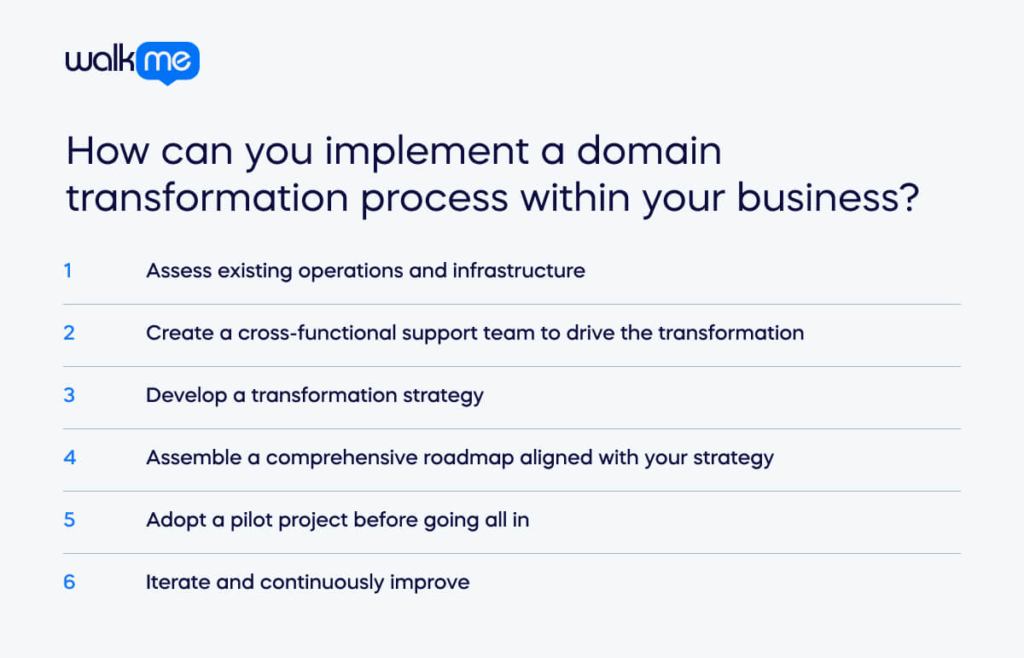Companies may need to undergo a digital transformation when they want to make significant changes to their processes. Different types of transformations work better for different companies. So, leaders should choose the right one for their needs.
Domain transformation involves moving beyond a company’s current market to explore new ones. For example, a company might develop a new B2B solution and then start selling it to other businesses, creating a new source of revenue.
Companies might choose domain transformation due to competition, new technologies, or industry changes. Economic downturns or a desire to improve efficiency can also drive this decision. Agile leaders should aim to make the transition as smooth as possible for their employees.
In this article, we will examine domain transformation. Next, we will consider why it is important, along with its benefits and challenges. Then, we will offer some implementation tips and a summary of other types of digital transformation.
What is a domain transformation?
Domain transformation occurs when a business expands into a new industry sector.
This strategy doesn’t involve leaving your current industry behind. Instead, it leverages your existing resources to explore and seize new opportunities.
Businesses pursue domain transformation by using digital tools to enter a different industry or domain. This process often involves creating new products, services, or business processes.
The goal is to establish a presence in the new market.
Why is domain transformation important?
Domain transformation is crucial because new technologies continuously reshape products and services. These changes blur industry boundaries and introduce new competitors. As a result, businesses have a significant opportunity to explore new markets beyond their current scope.
For instance, a business can use analytics software to track trends and customer behavior. In this way, big data helps decision-makers identify new market opportunities.
AI also makes the process of domain transformation important. It does this by making integrating new operations into the existing business easier.
For example, Paramount Advertising used generative AI to build a platform. This platform makes it easier for small businesses to create ads. Prices start at $500.
Paramount Ads Manager introduces small businesses to TV advertising, even if they’ve never considered it before. Normally, TV advertising is expensive and a service small businesses cannot afford. But now, they can create an ad by simply entering their website details through the Paramount website.
Cloud computing provides the necessary infrastructure for scaling into new sectors. Businesses can shift their operations and data to the cloud, enabling them to explore new territories without facing steep initial investments.
How can you implement a domain transformation process within your business?

These are the steps you need to consider when implementing a domain transformation:
Assess existing operations and infrastructure
Start by assessing the organization’s existing business operations, processes, and technology infrastructure. Then, identify areas for domain transformation by evaluating the organization’s strengths, weaknesses, opportunities, and threats.
Create a cross-functional support team to drive the transformation
While business leaders’ buy-in is important, gaining support from the entire company is crucial. Examine your current workforce and identify those who wield influence, exhibit innovation, and inspire trust.
Create a cross-functional team comprising high achievers to lead the domain transformation. This team should craft a vision for the domain transformation process that aligns with business objectives. Involving individuals connected to the organization ensures that the transformation process resonates throughout the company.
Develop a transformation strategy
Create a domain transformation strategy to provide the necessary framework for managing the transformation. Define what you seek to achieve and align your business goals with your vision. This strategy will guide you in implementing the specific changes needed.
Assemble a comprehensive roadmap aligned with your strategy
After defining the strategy, develop a comprehensive domain transformation roadmap. Outline the steps and timelines required to put in place the strategy. Include detailed plans, timelines, resource requirements, and milestones for each initiative.
These sources could include training and support to help employees adapt to new processes. Look for digital adoption solutions that empower people to take charge of their transformation journey.
Adopt a pilot project before going all in
Begin with an initial, smaller project to test your domain transformation strategy. Select a single team or process to implement the new platform. This allows you to confirm your assumptions and ensure this approach suits your business before committing in full.
Iterate and continuously improve
Remember, domain transformation is an ongoing, iterative process. Continuously track your progress and measure your results against established KPIs.
Establish a continuous employee feedback loop to help with process improvement. Ask them what’s working and find out where they are still struggling. This employee feedback can help improve the domain transformation process.
Benefits of a domain transformation
The main advantages of a domain transformation are:
Improves your existing customer base
Domain transformation helps businesses expand their customer base, increase sales, and improve revenue. Using technology, you can reach new markets, offer unique products or services, and enhance your sales and marketing efforts.
Enhances agility and real-time decisions
Access to real-time data empowers people to make strategic decisions aligned with business goals. In this way, businesses become more agile when responding to dynamic change. This means they can quickly adapt to new trends and launch new products or services.
Fosters increased collaboration and employee productivity
Once you’ve implemented a domain transformation process, take advantage of increased collaboration. This cross-collaboration occurs when individuals work together to establish new revenue streams.
When departments are linked in their goals, a strong working culture develops. This makes it easier to increase employee productivity.
Challenges of a domain transformation

The various challenges of domain transformation are:
It is difficult to financially plan for
Improper financial planning can mislead you about the necessary funding for domain transformation. Siloed strategies often lead to scope creep, extending deadlines, and inflating the initial budget.
It’s essential to understand domain transformation investment as strategic rather than operational. You must plan for the expected ROI and how you intend to use it. Moving into new markets requires revising complex, interconnected software.
Updating a legacy application needs analysis and foresight. Expertise is also required to ensure minimal downtime and seamless interaction within your existing infrastructure.
Security risks
Domain transformation aims to generate value, not just to go digital. Moving to the cloud and adopting new solutions to enter new markets comes with cybersecurity risks. A security-first approach can mitigate these risks by introducing proper security controls. These could include a zero-trust model or an identity access management (IAM) system.
Sustaining the enthusiasm of every employee in the transformation process
IT and engineering play significant roles in domain transformation. But, successful implementation, adaptation, and iterative change need efforts from everyone in the organization.
Domain transformation reshapes company structures, workgroups, job titles, and long-used processes. These changes can cause insecurity and fear among employees, leading to pushback.
Early and deep engagement from the CEO can help involve the entire company. This makes employees feel part of the initiative and aware of its positive business impact.
Transition plans and good communication are vital to changing employee attitudes. Ensure all employees understand why digital transformation is necessary. They also need to know why supporting domain transformation is important for all.
Cross-functional teams are also crucial for success. Leadership and empathy, which are soft skills, are essential in building support.
Organizations must also provide thorough employee onboarding training and support. This helps employees quickly learn how to use the new tools and understand their benefits.
Hard to quantify ROI
Determining return on investment (ROI) for domain transformation is challenging. Benefits may take time to see or be hard to measure.
Success in domain transformation covers more than financial gains. It includes improvements in customer experience, employee productivity, and business agility. The difficulty in measuring ROI can make companies cautious about investing. This affects the progress of domain transformation initiatives.
What are the other types of digital transformation?
To understand whether domain transformation is the right one for you, let’s explore the other types of digital transformation:
Cloud transformation
Cloud transformation helps organizations move their information systems to cloud computing environments. Companies may choose to transfer their entire infrastructure to the cloud. But, they might migrate only specific applications, data, or services.
This shift offers several benefits. It streamlines data sharing and storage, speeds up time to market, and enhances organizational scalability and flexibility.
Organizations can opt for several strategies for cloud adoption. Some opt for the public cloud. In this case, a third-party provider manages the data center. Others develop an internal cloud, known as a private cloud. Many companies use a hybrid approach. This combines both public and private clouds to meet their needs.
Business process transformation
Business process transformation focuses on improving internal operations. It automates manual procedures and invests in new software and research. The goal is to reduce costs, enhance efficiency, and minimize errors.
Leaders should consider several factors before implementing new systems. These include implementation timelines, change management strategies, and the urgency of the change. Transformations can also affect external vendors and customers. Effective management is necessary to handle changes in processes like accounts payable.
Business model transformation
Business model transformation involves shifting from traditional models to innovative digital ones. For example, investing in cloud computing can facilitate scalability and reduce infrastructure costs. Cloud computing also enhances collaboration and data sharing across teams and devices.
Data analytics play a crucial role by providing insights. These insights include market trends, consumer behavior, and operational performance. They enable businesses to make informed decisions, anticipate trends, and create proactive strategies. This could consist of personalized marketing campaigns.
Conducting market research is important for successful business model transformation. Companies should be proactive and understand market needs to navigate changes.
Cultural or organizational transformation
Cultural and organizational transformation involves reshaping a company’s values, behaviors, and structure. For example, adopting a remote work culture through the cloud represents a significant shift. Changing company culture is challenging. It requires aligning goals and values with employees.
Leaders should model the desired changes and work with change management professionals to support digital adoption. Effective communication is crucial. Employees are more likely to adapt if they understand the reasons for the changes and how to achieve them. Continuous learning and clear communication from leadership can ease the transition process.
Use a digital adoption platform to spearhead your domain transformation initiative
In the future, technological advancements will allow businesses to undergo domain transformation. This process can improve efficiency and competitiveness in the marketplace. But, organizations need to look beyond implementing new technology.
For a successful domain transformation, the complete support of employees is essential. With this support, organizations can enhance their operations, create new collaboration opportunities, and expand their service offerings. It can also help revolutionize their approach to the employee experience.
A digital adoption platform can help achieve these benefits. This tool acts as an educational software overlay. It guides users through unfamiliar systems or processes. It offers various resources such as guides, tutorials, demonstrations, and walkthroughs.Businesses can use a digital adoption platform to provide valuable digital support. This ensures a smoother transition and better adoption of new technologies.


